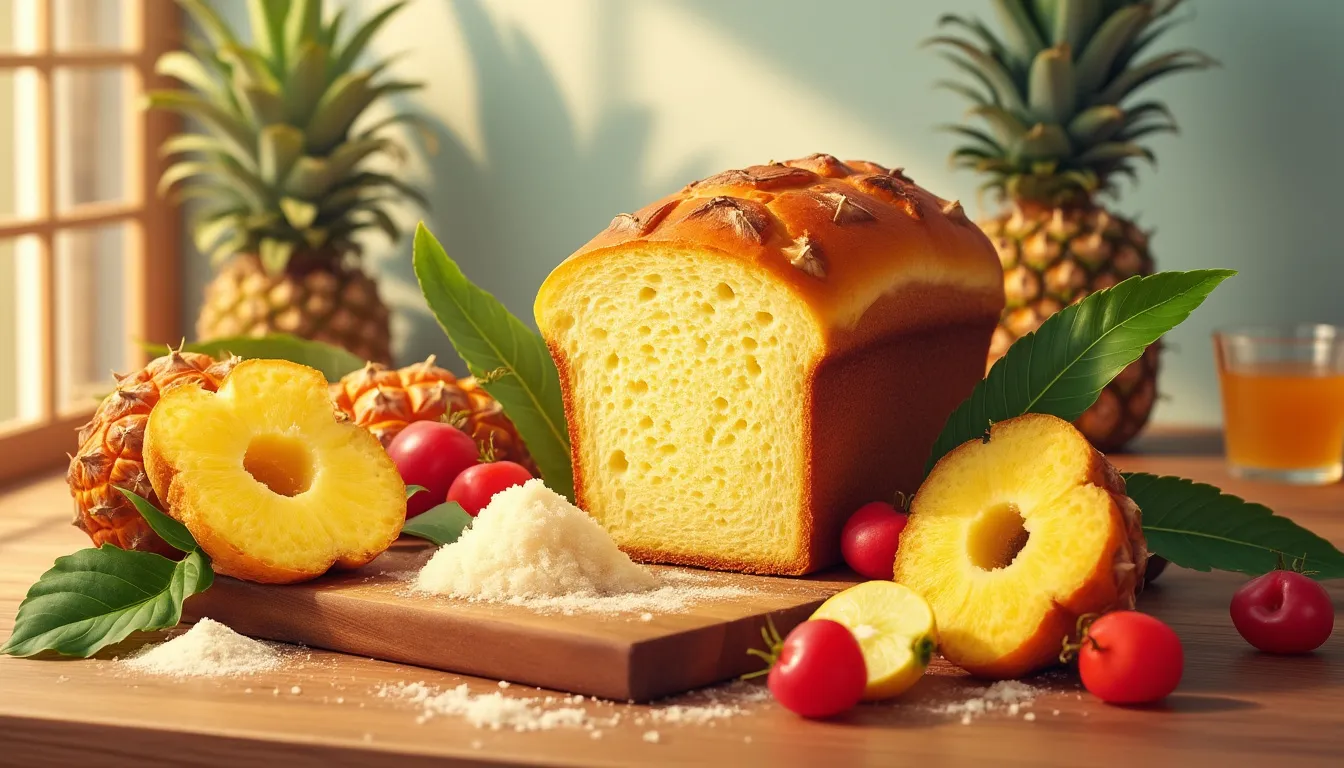Hawaiian bread, renowned for its sweet and fluffy texture, has become a staple in many households, often utilized for everything from sweet breakfasts to savory sandwiches. As health-conscious consumers increasingly scrutinize the nutritional value of their food choices, the question arises: Is Hawaiian bread a healthy option? This article delves into the nutritional profile of Hawaiian bread, offering a comprehensive look at its main ingredients and presenting a detailed breakdown of its caloric content, carbohydrates, sugars, and fibers. By comparing Hawaiian bread to other types of bread, readers can determine how it may or may not fit into a balanced diet. Moreover, we explore the health considerations and dietary impact of Hawaiian bread, analyzing the potential benefits of its ingredients, such as natural sweeteners and the absence of preservatives. We also discuss the implications for individuals following specific diets, such as low-sugar or low-carb diets, as well as those with dietary restrictions, like gluten intolerance. By examining both the advantages and potential drawbacks of consuming Hawaiian bread, this article aims to provide conclusive insights into its overall healthfulness, assisting readers in making informed dietary choices.
Nutritional Profile of Hawaiian Bread
Hawaiian bread, often recognized for its sweet and tender texture, is a popular choice for many households. It distinguishes itself from other types of bread through its unique flavor and ingredients. Understanding its nutritional profile is vital to assessing whether it can be considered a healthy choice.
Overview of the Main Ingredients Used in Hawaiian Bread
The distinct taste of Hawaiian bread primarily stems from its core components. Traditional recipes typically include enriched wheat flour, which forms the base of the bread. This flour is often combined with sugar, yeast, butter or oil, and non-fat milk, which contribute to the bread’s softness and rich flavor. A notable addition is pineapple juice or puree, which imparts a subtle sweetness and is partly responsible for the bread’s characteristic taste.
Additionally, the use of eggs enhances the texture, providing a fluffy and light consistency. The combination of these ingredients, along with varying levels of added sugar, differentiates Hawaiian bread from other bread types, such as whole wheat or multigrain varieties.
Detailed Breakdown of the Calories, Carbohydrates, Sugars, and Fibers in Hawaiian Bread
To determine whether Hawaiian bread aligns with a balanced diet, examining its caloric and nutritional content is essential. A typical slice or serving of Hawaiian bread contains approximately 90 to 110 calories. However, variations in recipe and brand can affect this calorie count. The caloric content primarily derives from carbohydrates and fats, integral to its soft and moist texture.
Carbohydrates are a significant component of Hawaiian bread, accounting for roughly 15 to 20 grams per serving. This quantity contributes to the bread’s energy-producing potential but also requires monitoring for individuals managing their carbohydrate intake.
The sweetness of Hawaiian bread is further enhanced by sugars, with each serving containing around 4 to 6 grams. This is relatively higher when compared to traditional savory breads that contain less than 3 grams of sugar per serving.
Conversely, fiber content in Hawaiian bread tends to be lower, approximately 1 gram per serving. This is a concern for those prioritizing high-fiber diets aimed at promoting digestive health and enhancing satiety.
Comparison with Other Types of Bread to Determine How It Fits into a Balanced Diet
When evaluating Hawaiian bread alongside other common bread varieties, several factors must be considered. Compared to whole wheat or multigrain bread, Hawaiian bread generally contains fewer nutrients, such as vitamins, minerals, and fibers. For individuals aiming for nutritional density, whole wheat or multigrain bread may be superior due to their enriched fiber and protein content, offering prolonged satiety and digestive benefits.
On the other hand, Hawaiian bread is more akin to white bread or brioche in its nutritional makeup but tends to have more sugar due to ingredients like pineapple juice and added sugars. While white bread typically offers an average of 1-2 grams of sugar per slice, Hawaiian bread surpasses this, demanding mindful consumption, particularly for those managing sugar intake. Hawaiian bread’s unique flavor profile, however, can make it an appealing occasional treat or a creative ingredient in various culinary applications.
In summary, Hawaiian bread’s nutritional profile reveals a bread rich in flavor but also in sugar and lower in fiber, which can position it as a less ideal choice for those following low-sugar or high-fiber diets. When consumed in moderation alongside a balanced diet rich in whole grains, fruits, and vegetables, Hawaiian bread can contribute to dietary diversity and enjoyment without overshadowing nutritional goals.

When examining the health considerations and dietary impact of Hawaiian bread, it’s essential to delve into both the potential benefits and drawbacks of its key ingredients. Notably, Hawaiian bread is distinguished by its unique flavor, often characterized by a slight sweetness derived from ingredients such as pineapple juice, honey, or brown sugar.
Potential Health Benefits of Hawaiian Bread’s Ingredients
Hawaiian bread typically includes a combination of sweeteners that adds to its distinctive taste. Ingredients like honey and pineapple juice, when used in moderation, offer certain nutritional advantages. Honey, for instance, is renowned for its antioxidant and antimicrobial properties, which can contribute positively to immune health. Pineapple juice provides vitamins and minerals, including vitamin C and manganese, that support bone health and immune function. The natural sweetness of these ingredients can reduce the need for refined sugars, thereby offering a marginally healthier alternative to breads laden with high-fructose corn syrup.
Another noteworthy feature of some Hawaiian bread varieties is the absence of artificial preservatives. Many health-conscious consumers are increasingly wary of preservatives due to their potential link to allergies and digestive issues. Choosing breads without these additives can be a positive choice for those with sensitivities, aiming for an elimination style diet or simply looking to consume more natural food sources. Additionally, Hawaiian bread can be enriched with vitamin D and calcium, supporting bone health and helping to meet daily nutritional requirements.
Implications for Specific Diets
While there are some benefits to incorporating Hawaiian bread into a diet, certain considerations are necessary for those following specific dietary regimens. For individuals adhering to low-sugar diets, Hawaiian bread’s innate sweetness can pose a challenge. Even though it can contain more natural sweeteners, individuals focused on reducing sugar intake—such as those managing diabetes or seeking weight loss—should monitor consumption carefully. Checking labels for the amount of added sugars can be a useful practice in such cases.
Similarly, for those on low-carbohydrate diets, Hawaiian bread may not be the most suitable option. Owing to its traditional ingredients and preparation methods, it typically contains a higher carbohydrate content compared to whole grain or low-carb alternatives. This makes it less ideal for ketogenic or Atkins-style diets, where minimizing carb intake is essential.
In terms of dietary restrictions, Hawaiian bread traditionally contains wheat. Therefore, it is not naturally gluten-free and is unsuitable for individuals with celiac disease or gluten sensitivity unless a specifically labeled gluten-free version is available. As awareness grows, recipe modifications and commercial options may cater to such dietary needs, but these alternatives may also differ in taste and texture.
Concluding Insights on Is Hawaiian Bread Healthy?
Considering the pros and cons, the question of Is Hawaiian Bread Healthy cannot be answered with a simple yes or no. For those who can incorporate it into their diet while maintaining a balance, Hawaiian bread can be enjoyed as an occasional indulgence or as part of a festive meal. Its unique flavor and traditional craftsmanship appeal to a wide range of consumers. However, for those with specific health goals or dietary restrictions, careful scrutiny of nutritional information and portion sizes is paramount.
Ultimately, whether Hawaiian bread serves as a healthy choice depends vastly on individual dietary needs, consumption habits, and overall lifestyle. As with any food, moderation and balance are key components in fostering a healthy diet. Always cross-reference its consumption with your nutritional objectives and consult healthcare professionals for tailored dietary advice. By considering both the potential health benefits and limitations, consumers can make informed decisions that align with their wellness goals.
In conclusion, whether Hawaiian bread can be deemed a healthy choice largely depends on the context of an individual’s overall diet and specific health goals. The nutritional profile of Hawaiian bread reveals that it contains relatively high amounts of carbohydrates and sugars due to its sweet ingredients, such as pineapple juice and honey. Compared to other bread types, Hawaiian bread typically has more sugar and calories, which could pose challenges for those following low-sugar or low-carbohydrate diets.
Despite the potential drawbacks, Hawaiian bread also offers certain health benefits. Its ingredients often lack preservatives, and it may contain some beneficial nutrients depending on the recipe. However, for individuals adhering to specific dietary restrictions such as gluten-free diets, Hawaiian bread is not suitable unless a specially formulated alternative is available.
Ultimately, when evaluating if Hawaiian bread is healthy, it is crucial to balance its delightful flavor and texture with dietary needs and health goals. Moderation is key. For those without restrictions that disqualify its ingredients, enjoying Hawaiian bread as an occasional indulgence could certainly fit within a balanced diet. However, consuming it regularly requires careful planning and consideration of its higher sugar and calorie content to ensure it complements other healthier food choices.







